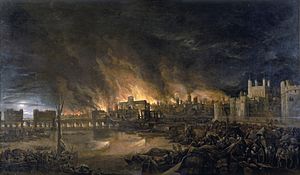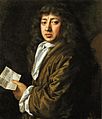Great Fire of London facts for kids
The Great Fire of London was a huge fire that swept through the city of London in 1666. It burned for three days, from September 2nd to September 5th. This terrible event destroyed many parts of the city, changing London forever.
The fire came close to important areas like Westminster, where rich people lived, and King Charles II's home, the Palace of Whitehall. Luckily, these places were saved. However, the fire destroyed about 13,200 houses, 87 churches, and the famous Old St Paul's Cathedral. Most government buildings were also lost. It's thought that 70,000 out of London's 80,000 residents lost their homes. We don't know exactly how many people died, but only a few deaths were officially recorded.
Contents
How the Fire Started
The Great Fire began just after midnight on Sunday, September 2nd. It started at a bakery on Pudding Lane, owned by a man named Thomas Farriner. The fire grew very quickly.
Back then, firefighters tried to stop fires by creating "firebreaks." This meant tearing down buildings around the fire so it couldn't spread. But the Lord Mayor of London, Sir Thomas Bloodworth, wasn't sure what to do. By the time he gave the order to pull down buildings, it was too late. The fire was already too big.
The Fire Spreads
On Monday, the fire moved north into the heart of the city. Some people thought that foreigners, like the French and Dutch, were starting the fires on purpose. This was because England was fighting a war against France and the Netherlands at the time, called the Second Anglo-Dutch War.
By Thursday, the fire had spread across most of the City of London. It destroyed St. Paul's Cathedral and even crossed the River Fleet. It came very close to King Charles II's royal court at Whitehall.
Stopping the Fire
People believe two main things helped stop the fire:
- The strong east winds that were making the fire spread finally slowed down.
- The guards at the Tower of London used gunpowder to blow up buildings. This created wide gaps, or firebreaks, that stopped the fire from spreading further to the east.
Life After the Fire
The Great Fire caused huge problems for London's people and economy. Many people had lost everything. King Charles II actually encouraged people to leave London and live elsewhere. He was worried that the refugees, who had lost their homes, might start a rebellion.
Even though there were many ideas for rebuilding London in a completely new way, the city was mostly rebuilt using the same street plan it had before the fire.
Interestingly, the fire is also thought to have helped get rid of the Great Plague. This terrible disease had hit London in 1665, killing about 70,000 people out of a population of 90,000. The fire destroyed many of the rats and fleas that carried the plague, helping to end the outbreak.
Images for kids
-
The Great Fire of London, painted in 1675. This shows how it might have looked from a boat near Tower Wharf on the evening of Tuesday, September 4, 1666. On the left is London Bridge, and on the right is the Tower of London. Old St Paul's Cathedral is in the distance, surrounded by the tallest flames.
-
A map of Central London in 1666. The area that burned is shown in pink and outlined with dashes.
-
King Charles II.
-
"Firehooks" were tools used to fight fires in 1612, like this one in Tiverton, England.
-
"It made me weep to see it." This is Samuel Pepys (1633–1703), painted in 1666, the year of the Great Fire. He wrote a famous diary.
-
The front page of The London Gazette from September 3–10, 1666. It tells the story of the Great Fire. Click to enlarge and read.
-
Ludgate is on fire, with St Paul's Cathedral (the square tower without the spire) catching fire in the distance. This oil painting is from around 1670.
-
John Evelyn had a plan to rebuild a very different City of London, but it was never used.
-
Christopher Wren also had a plan for rebuilding London, but it was not chosen.
-
The Monument to the Great Fire of London stands tall today.
See also
 In Spanish: Gran incendio de Londres para niños
In Spanish: Gran incendio de Londres para niños
















